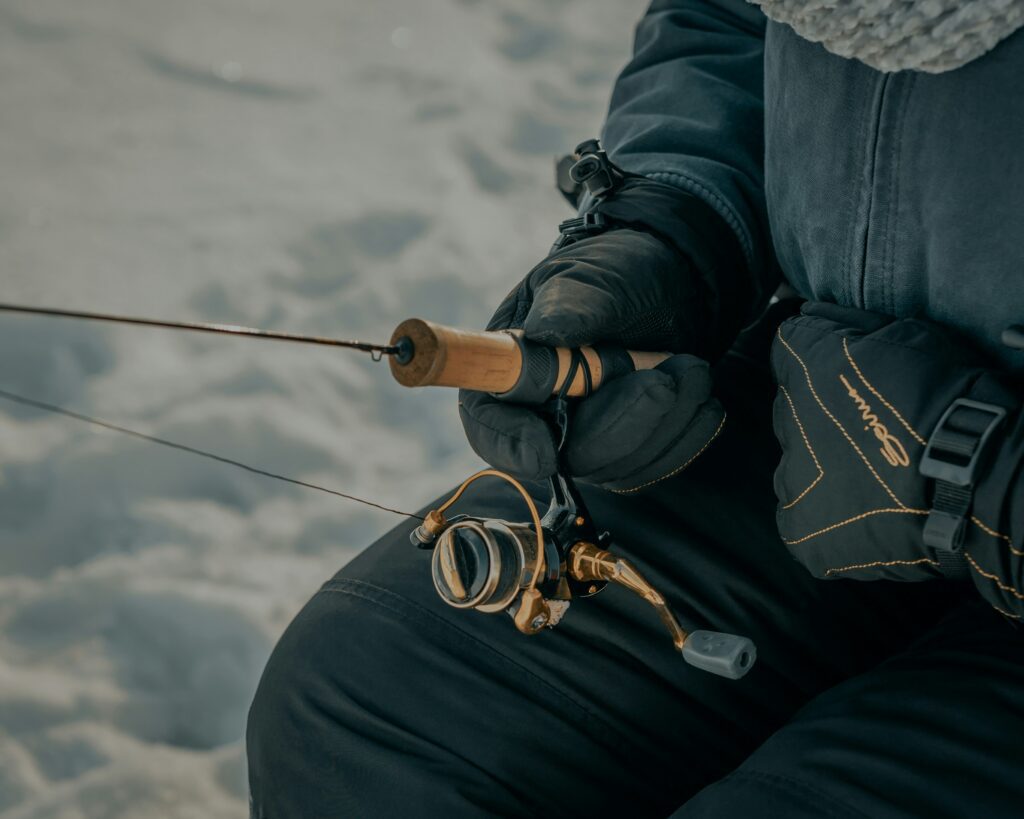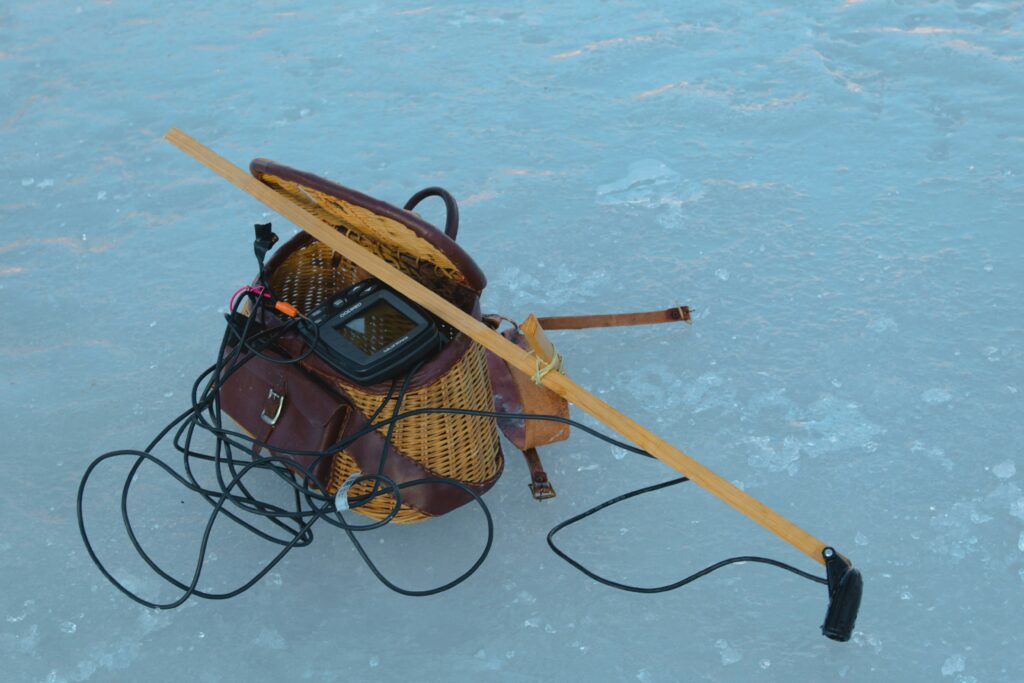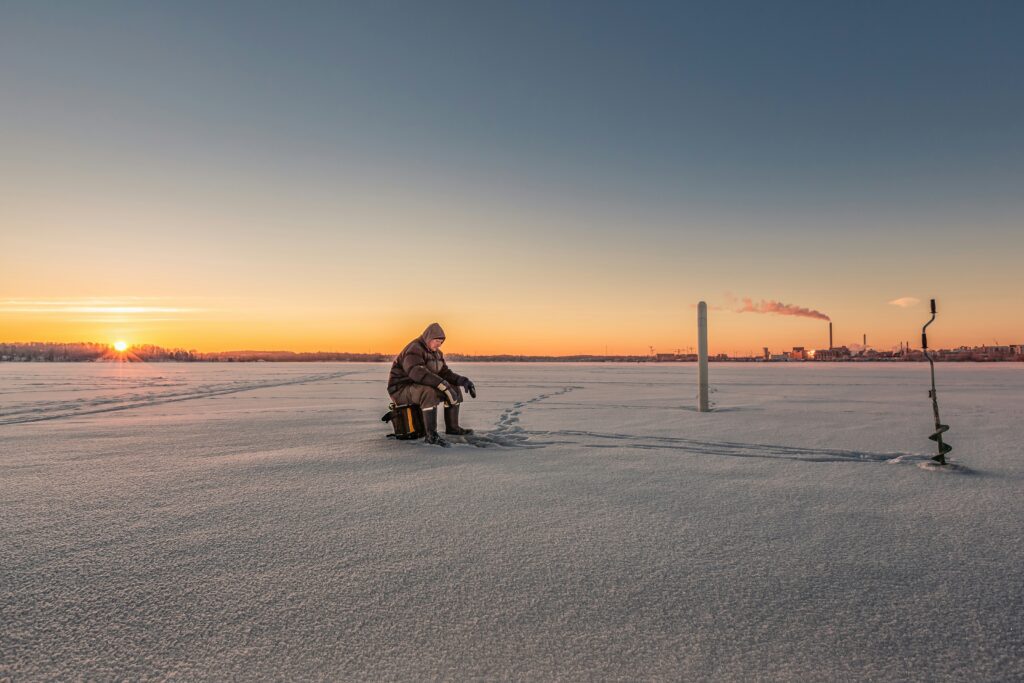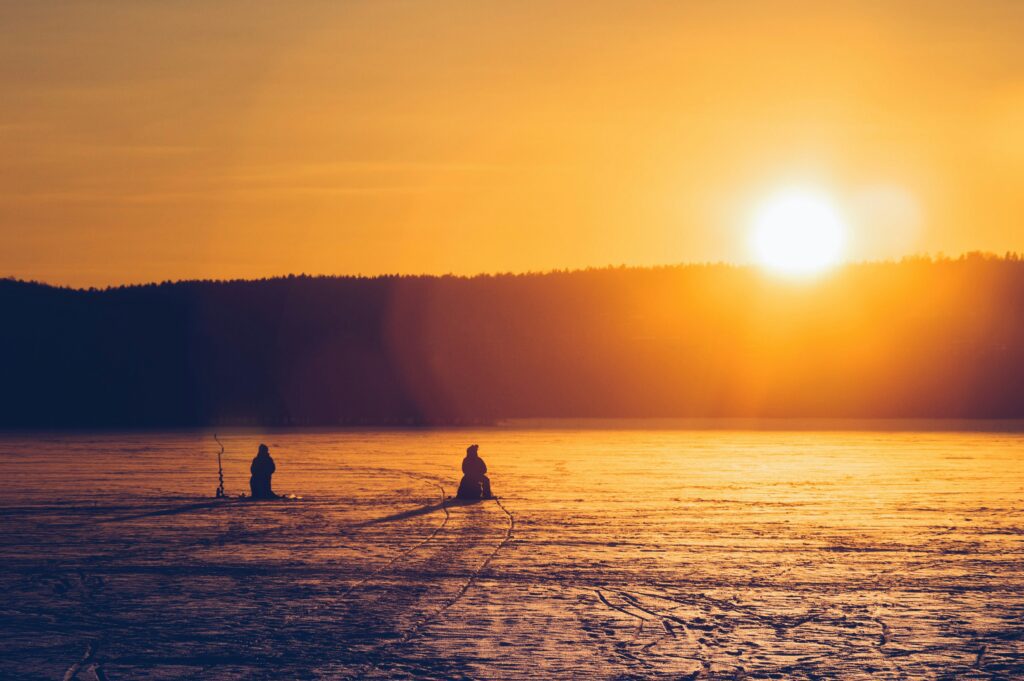Ice Fishing for Beginners
Imagine standing on a frozen lake, the icy stillness surrounding you as the early morning light reflects off the snow-covered expanse. The air is crisp, biting, but you’re bundled in layers of warmth, anticipation building.
Ice fishing is more than just a winter sport—it’s an adventure that connects you to nature in its most elemental form. For those seeking a break from the ordinary, ice fishing offers a blend of solitude, skill, and the excitement of the catch.
Whether you’re drilling your first hole or perfecting the art of jigging, this guide will take you through the essentials, from top equipment recommendations like Frabill rods and Eskimo ice augers, to expert tips on technique and safety. Ready to experience the magic beneath the ice?
Starting with the Basics of Ice Fishing

Venturing into ice fishing can be a rewarding winter activity. Whether you’re looking to haul in a hefty catch or enjoy the serenity of a frozen landscape, learning the essentials will set you up for success. Let’s break down what you need to begin this chilly adventure.
Understanding the Basics
Ice fishing involves more than drilling an ice hole and waiting for fish to bite. This winter sport requires knowledge of the terrain, understanding the behaviour of fish in cold environments, and implementing the right techniques to entice them. Ice fishers use specialized gear designed to withstand harsh conditions and maximize the chances of a catch.
The Ice Fishing Concept Explained
Ice fishing is the practice of fishing through an opening in the ice on a frozen body of water. Safety is paramount. You must ensure the ice is thick enough to support your weight. As a rule of thumb, at least four inches of solid, clear ice is recommended for walking. The ice must be thicker to withstand larger groups or vehicles.
The Rich History of Ice Fishing
Ice fishing has roots that trace back to indigenous peoples who fished to sustain their communities during frigid winters. Today, ice fishing is a mix of survival skills and sport with an enthusiastic community eager to share their expertise.
Ice Fishing Gear and Equipment
Your gear checklist should include an auger to drill holes, a specialized ice fishing rod, lures or bait suited for cold water species, a skimmer to clear ice chips from holes, and a bucket or chair to sit on. Top brands like Strikemaster and Eskimo offer reliable augers. Meanwhile, rods from brands like Fenwick and Shimano are praised by many ice anglers.
Essential Tools for a Successful Trip
The Maine Department of Fisheries & Wildlife believes you don’t need a tonne of newfangled equipment to get started with ice fishing. They say, “Like most activities, there are a ton of items that you could use, but getting set up with the essentials is all you need to start.” Alongside your rod and auger, remember to pack a tackle box with jigs, safety spikes, and a scoop. For an extra edge, consider electronics like a fish finder.
Choosing the Right Reels and Ice Fishing Rods
Rods designed for ice fishing are typically shorter for better maneuverability. Look for sensitive tips to detect bites and sturdy builds to handle fish. Reels should be smooth with an easy drag system, keeping your line taut without snapping.
Safety Precautions on Frozen Waters
Safety is non-negotiable. Louis Porter, Vermont Fish & Wildlife commissioner says, “Once we have sustained cold weather to form good ice, ice fishing can be safe and a lot of fun. But when we go onto the ice, we need to use good judgment and observe several ice fishing safety precautions.” Always inform someone of your trip details, carry ice picks, wear a life jacket, and stay aware of weather conditions.
Assessing Ice Thickness and Quality
Use a quality auger to drill test holes and ensure ice thickness is consistent. Clear, blue ice is typically stronger than white or opaque ice. Carry a tape measure to check ice at regular intervals. Thickness can vary across a single body of water.
Preparing for Emergency Situations
Prepare a safety kit with items like waterproof matches, a whistle, warm blankets, and first aid supplies. Know the signs of hypothermia and frostbite, and be ready to act quickly.
As you gear up for your ice fishing expedition, remind yourself of these tips. They will improve your chances of a big catch and ensure you return home safely. No fish is worth risking your well-being over.
Selecting the Ideal Ice Fishing Location
Finding the perfect spot for ice fishing greatly impacts the success of your trip. You want to discover that sweet spot where the ice is safe and the fish are plentiful. Here’s how to zero in on the best locations, set up your ice shack, and drill your hole.
Targeting the Right Bodies of Water
Lakes, ponds, and reservoirs provide ample opportunities for ice fishing. The key is to look for bodies of water that sustain a good fish population and freeze over reliably. In North America, for example, you might target the renowned Lake of the Woods, famous for its abundant walleye.
Lakes, Ponds, and Reservoirs
When considering lakes, ponds, and reservoirs, focus on depth and structure. Deep areas with sudden drop-offs or submerged structures like rocks and fallen trees can be hot spots for fish in winter.
Rivers and Streams for Ice Fishing
Fishing in rivers and streams requires special attention to ice thickness. Fast-moving water can create uneven and dangerous conditions. However, areas where the current slows can be prolific. Fish tend to gather in slower-moving water to conserve energy.
Researching Local Fishing Spots
Before heading out, do your homework. Researching local fishing spots will save you time. Check out area-specific ice fishing forums online for recent fishing reports, ice conditions, and fish activity.
Locating Fish Habitats under the Ice
You may not see them at first, but fish are down there! Fish congregate around aquatic plant life and structures under the ice. A good fish finder or an underwater camera can be invaluable for identifying prime spots.
- Tip: For precision, use a reliable auger to drill clean holes, like those from Eskimo or StrikeMaster.
Gathering Information from Fellow Anglers
Connecting with fellow anglers can be fun and informative. The Michigan Department of Natural Resources recommends you “Find a good local source – a bait shop or fishing guide – that is knowledgeable about ice conditions on the lake you want to fish on.
Whether heading out to a local pond or embarking on an adventure to a frozen expanse like Lake of the Woods, selecting the right ice fishing location is a blend of science, instinct, and community wisdom. Stay safe, and happy drilling!
Ice Fishing Techniques and Tips

It doesn’t matter if you’re on the hunt for your next trophy fish or looking to enjoy the stillness of a winter’s day; ice fishing is incredibly rewarding. Mastering a few key techniques and tips is essential to increase your chances of success. From using the correct ice fishing gear to understanding fish behaviour, let’s explore strategies that can make your ice fishing adventure productive and enjoyable.
The Art of Drilling Holes
Drilling is the first step towards a triumphant day on the ice. Keep in mind that the thickness and transparency of the ice are indicators of its strength. Use an ice auger to create holes 8 to 10 inches in diameter. This width allows ample space to fish through without compromising the ice’s integrity.
Manual vs. Power Augers
Are you old school or do you like having technology on your side? Manual augers are budget-friendly and quiet, perfect for a serene day on the ice. Power augers, on the other hand, slice through the ice with ease, saving your energy for reeling in the big ones. Brands like Eskimo and Strikemaster are favourites among anglers.
Maintaining a Grid Pattern on the Ice
When positioning your holes, think like a chess player. A grid pattern maximizes coverage and can be key to finding fish. Drill holes at various depths and distances to strategically search the water column. Keep your grid organized so you can systematically return to promising spots.
Setting Up Shelters and Shanties
Create a comfortable base camp. Ice shanties can provide shelter from the elements, especially during long fishing sessions. Consider adding a heater and comfortable seating, turning your ice fishing outing into a warm winter retreat.
Portable Ice Fishing Shelters
Portable shelters like those from Otter or Clam allow you to move with the fish. They’re light, easy to set up, and can be towed using a sled. Never compromise on comfort for convenience; with portable shelters, you can enjoy both.
Permanent Ice Fishing Huts
For those who return to the same spot each season, permanent huts are a welcome comfort. Constructed of wood or metal and equipped with various amenities, these fishing huts offer a sturdier, home-like structure on the ice.
Bait and Lure Selection
Choosing the right bait or lure can positively impact your day’s outcome. From colourful jigs to irresistible wax worms, matching your offering to the fish’s preferences increases your chances of a bite.
Live Bait vs. Artificial Lures
What’s in your tackle box today? Live bait like minnows tempt fish with their natural movement. However, artificial lures are more durable and can be just as effective when used right. Plus, they come in endless designs to mimic different prey.
Matching Baits to Targeted Fish Species
Do some homework on your target species. Pike might go for larger lures, while panfish can’t resist a dainty jig tipped with a worm. What works for one might not entice another.
Ice Fishing Techniques
There’s more than one way to hook a fish under the ice. Jigging is an active technique involving short, sharp lifts of the rod. Don’t overlook tip-ups. This piece of ice fishing equipment signals with a flag when you’ve got a bite. For more experimental ice fishers, trolling can yield surprising catches.
Jigging, Tip-Ups, and Trolling
Jigging involves rhythm, tip-ups require patience, and trolling needs a touch of technology—think flashers for spotting fish in real time. Each method has its own appeal and effectiveness. Avid ice fisher Dalius Rakutis advises “Don’t jump from one fishing technique to another. It’s better to master one and go from there.”
Reading Fish Behavior through the Ice
Trying to predict a fish’s next move is like a game. Use a flasher to understand how fish react to your lures or bait and adjust your technique accordingly. Fish under ice follow patterns; it’s your job to decipher them.
Equip yourself with the right gear, get to know your quarry, and fine-tune those techniques. Ice fishing doesn’t just take patience and luck. You have to understand the water beneath you as well as the ice you’re standing on. Happy fishing!
Targeted Ice Fishing Species
Ice fishing in wild winter landscapes provides an adventurous twist to your fishing experience. Kit up and explore the most coveted species sought after by ice anglers.
Pursuing Panfish under the Ice
Did you know that panfish provide some of the most exciting ice-fishing action? Bluegill, pumpkinseed, and sunfish are all panfish you might snag through the ice. These little fighters are plentiful and can keep your reels spinning all day long.
Catching Perch, Bluegill, and Crappie
Yellow perch are prized for their sweet-tasting fillets. Crappie and bluegill are a blast to catch using light ice fishing rods, making them perfect for a family outing. They’re generally found in shallower waters, huddling around structures.
Tips for Panfish Ice Fishing
- Drill multiple ice holes to find schools.
- Use tiny jigs and live baits like wax worms or small minnows.
- Don’t forget sensitive rods like the Shakespeare Ugly Stik GX2 for finesse.
Chasing After Trout and Salmon
These species are popular due to their larger size and fighting prowess. Catching trout and salmon through the ice requires patience. Knowledge of their preferred cold-water habitats is also vital.
Ice Fishing for Rainbow, Brook, and Lake Trout
Rainbow, brook, and lake trout are often found in different layers of the water column. Drop your line in varied depths to locate them. Sometimes, this means going as deep as 40 feet, as noted by experienced anglers targeting lake trout in Alaska or the Great Lakes region.
Strategies for Catching Icebound Salmon
For landlocked salmon, the first 15 feet below the ice can be golden. Maine Department of Inland Fisheries & Wildlife experts suggest smelts or other similarly sized legal bait fish for attracting salmon.
The Thrill of Ice Fishing for Walleye
Walleye – you’re in for a real treat when you catch these elusive fish! One of the most popular species for ice anglers, walleye adapt well to the cold and provide a rewarding challenge.
Secrets to Catching Elusive Walleye
Adaptability and cunning make the walleye a prized catch. Use live minnows or lures that mimic the movement and flash of small baitfish to entice them. They can be more active during low-light conditions. Timing is crucial.
Prime Spots for Walleye Ice Fishing
According to avid anglers on IcyFishing.com, structures like weed beds, drop-offs, and areas with significant changes in depth are walleye hotspots. Do some scouting to boost your chances of success.
Ice fishing is all about the experience. Stay warm, stay safe, and enjoy your icy adventure!
Advanced Ice Fishing Techniques

Ready to step up your game on the ice? Whether targeting elusive trophies or competing at the highest levels, advanced ice fishing requires skill, patience, and specialized gear. Let’s break down the tactics and tools you’ll need to triumph in the chill.
Ice Fishing for Northern Pike and Muskie
Northern pike and muskie are aggressive predators. Catching these fish through the ice requires careful strategy. Use large, lively baits to mimic their natural prey.
- Location: Find weed lines and drop-offs where big fish hunt.
- Bait: Opt for big shiners or suckers under a tip-up for pike.
Landing Big Predators on Frozen Waters
For those monsters beneath the ice, your regular gear won’t cut it. You’ll need heavy-duty ice fishing gear that can handle the fight.
- Rod Choice: A stout rod with plenty of backbone to set the hook hard.
- Line: Braided lines with high sensitivity to feel the bite and withstand sharp teeth.
Lure Choices and Strategies
Your arsenal of lures can make or break your outing. Jigs tipped with minnows, spoons, or flasher rigs are popular choices that can lead to success.
- Tip: Change up your lure’s motion to mimic injured prey, triggering an attack.
Deep Freeze: Ice Fishing in Extreme Cold
Chills and thrills go hand in hand when ice fishing in extreme cold. Fish are less active in bitter temps, so finesse is key.
- Tactics: Use subtle jigging techniques to entice lethargic fish.
- Clothing: Dress in layers, and don’t forget a thermal hat and gloves.
Tackling Subzero Temperatures
When temperatures plummet, safety and comfort are paramount. Keep a heater in your ice shelter, and always stay dry to avoid hypothermia.
- Tip: Battery-powered heaters offer warmth without fumes.
Specialized Gear for Extreme Ice Fishing
If you’re experiencing the true deep freeze, wrap up adequately to keep the cold at bay. Think insulated boots, an all-weather suit, and ice fishing gear designed to handle the chill.
- Gear: Brands like Frabill and Strikemaster are preferable for their durability and cold resistance.
The Art of Ice Fishing Competitions
Ice fishing competitions are a rewarding way to put your angling acumen to the test. They also serve as fun social events. Chill out with fellow ice anglers and pick up on new tricks from your competitors.
- Prep: Pre-fishing the tournament site can give you an edge.
Ice Fishing Derbies and Tournaments
In tournaments, sometimes it’s actually about quantity rather than size. Ice fishing gear, knowledge, and a keen understanding of the water can see you rise to the top.
- Strategy: Keep mobile. If a hole’s not hitting, move on!
Preparing for Competitive Ice Fishing
Ahead of the competition, drill multiple ice holes to cover more area and test different waters. Fast thinking and adaptability could secure your win.
- Equipment: Use a GPS to mark productive spots and track movements.
Advanced ice fishing isn’t for the faint of heart. Are you ready to brave the cold for your next big catch? If you answered yes, then ice fishing could be your next thrilling winter conquest. With the right techniques and gear, the frozen depths are your playground.
Making the Most of Your Ice Fishing Trip

When embarking on an ice fishing adventure, the experience is not solely about the catch. You should also step back and enjoy the serene, icy environment to make the most of your trip. With the right preparations, you can enjoy comfortable meals, capture stunning photographs, and create lasting memories on the ice.
Preparing Comfortable Ice Fishing Meals
Comfort is a crucial element of any outdoor activity. Ice fishing is no exception. Before you set foot on the ice, think about meals that provide warmth and nutrition. Here’s a tip: pre-made chilli or stew can be reheated on a portable stove for a hearty meal that keeps energy levels up.
Cooking Fresh Catches on the Ice
There’s nothing more satisfying than cooking your fresh catch right on the ice. The Maine Department of Inland Fisheries & Wildlife agrees. They say, “One of the greatest benefits of fishing is being able to cook and consume fish that rivals and surpasses the quality and freshness of what you’d find in the finest dining establishments.“ A simple, portable grill will do. Fish like perch or crappie, when cleaned and seasoned, can be cooked in minutes.
Packable Meals for Extended Trips
If you’re planning a full-day or multi-day trip, pack nutrient-dense, non-perishable foods like nuts, energy bars, and dried fruits. These items won’t take up much space. Plus, they’re excellent for maintaining high energy levels.
Ice Fishing Photography and Memories
Bring a good-quality camera to capture the silent beauty of the winter landscape. Photos of your ice fishing setup, with rods such as the HT Enterprises Ice Blue Super Flex, make for great memories to share back home.
Capturing Your Frozen Adventures
Ice fishing presents unique opportunities for photographing wildlife and frosty escapades. Invest in a waterproof and cold-resistant camera to withstand the conditions. Remember, golden hour light can make your icy backdrop absolutely magical.
Documenting Your Ice Fishing Achievements
Keep a journal or a digital log on your phone to note the conditions, the tackle used, and the fish you catch. Not only does it serve as a personal record, but it can also help you refine your ice fishing basics for future trips.
Preparation can make or break your ice fishing experience. With these tips and your gear in check, you’re ready to make the most of your time on the ice.








